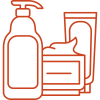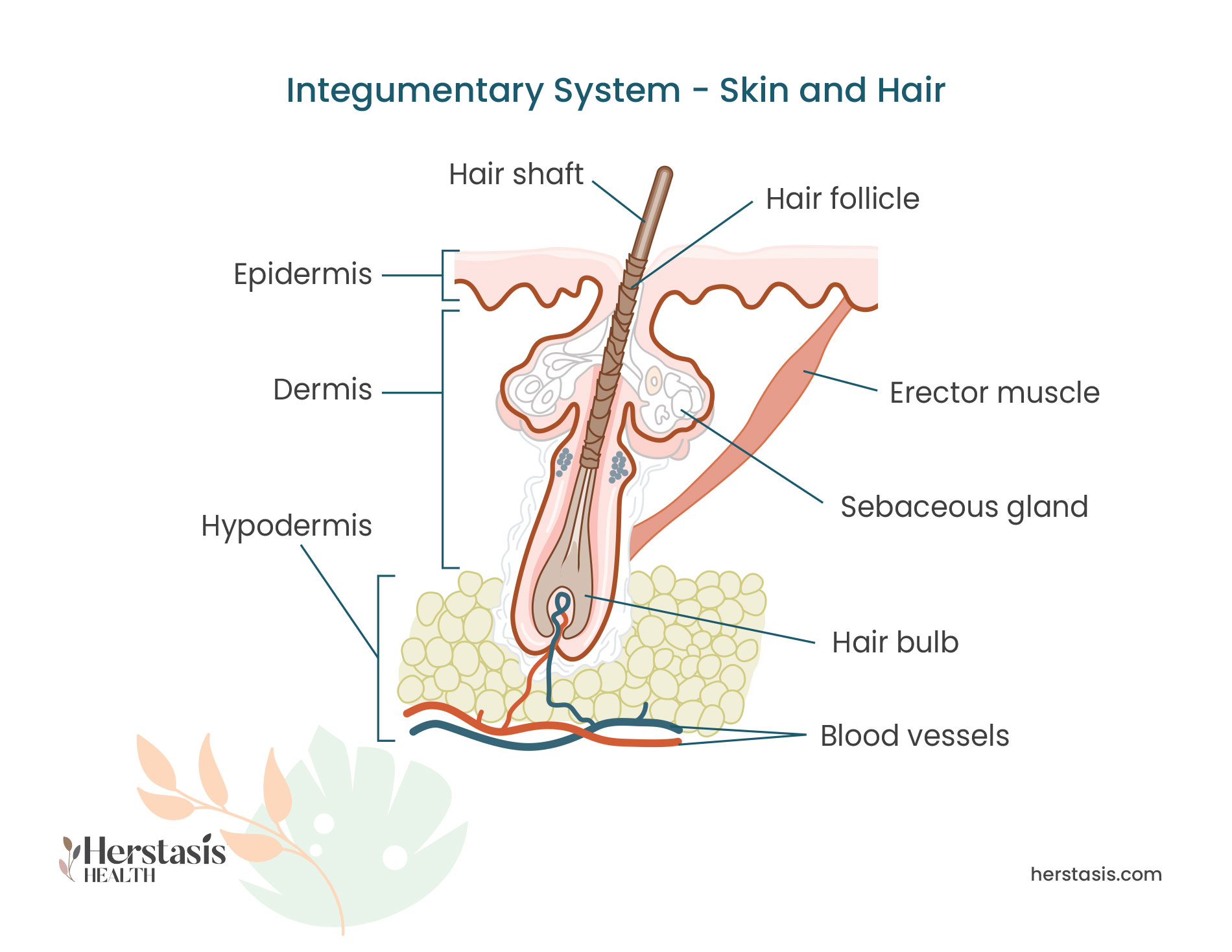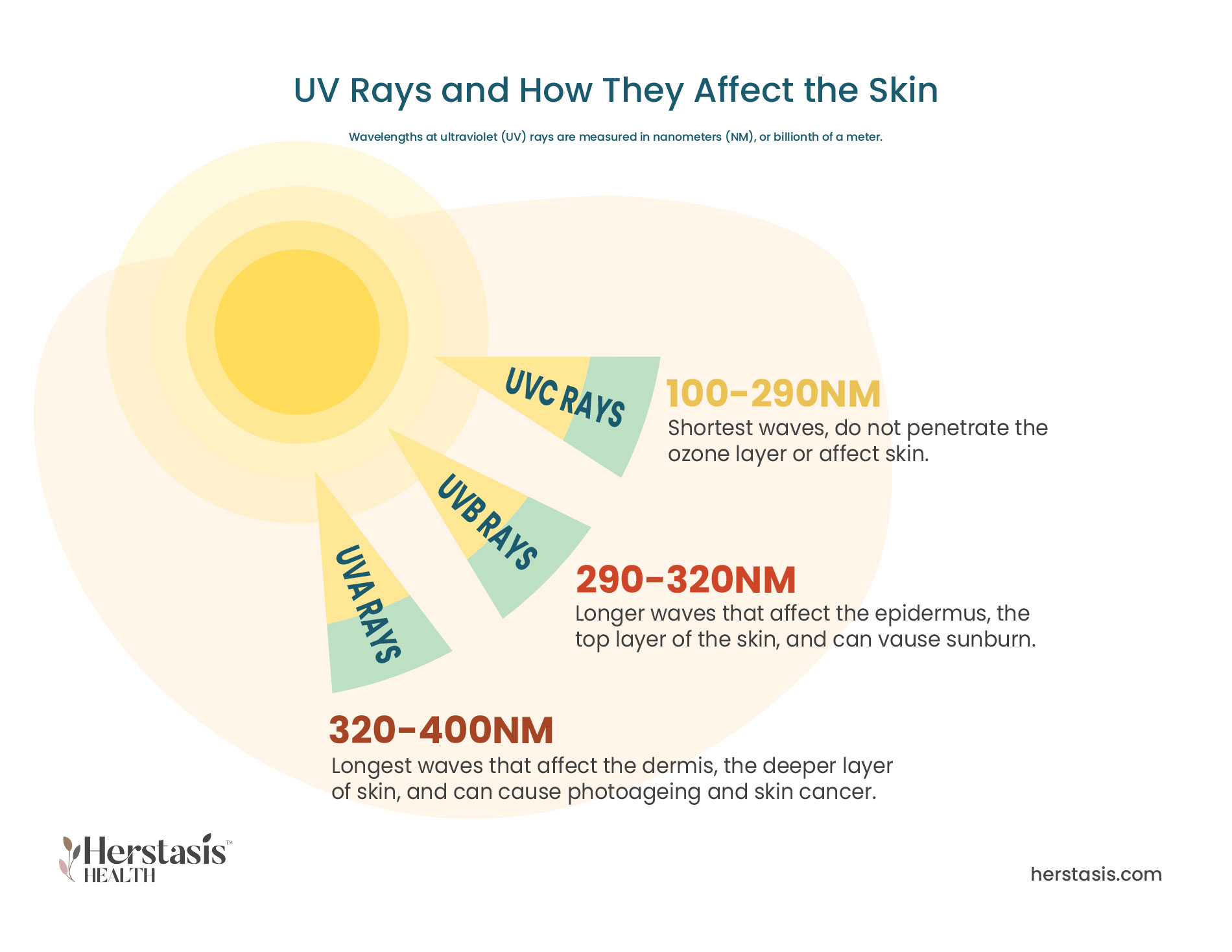What are the Changes to Skin?
Your skin serves a critically important role in your health, but most of us pay attention to it because it forms a large part of our external identity. For most of us, the importance of feeling good about our skin cannot be overstated – and this is why cosmetics and skin-care products are billion dollar industries in our society.
Aging is a fact of life. While that is easy to understand, it can be difficult to experience, especially because changes to our skin seem to happen suddenly. It may seem sudden, but in fact changes to your skin have been happening for decades. Daily skin care and constant use of sunscreens can delay signs of aging, but at some point they will become obvious. Additionally, your past behaviours – especially your use of sunscreen and your history of smoking – will have an impact on how quickly your skin shows its age, and how significant those changes are.
Changes in your levels of estrogen during the menopausal transition also play a big role in changes to your skin because estrogen is very involved in your skin’s health and repair (if damaged).
For women, the menopausal transition can lead to multiple symptoms affecting the skin, hair and nails. Common symptoms include:
- age spots;
- skin growths;
- bruising;
- dry skin;
- itching;
- wrinkles;
- presence of jowls;
- slack, sagging, loose skin;
- large pores;
- acne; and
- changes in body odour.
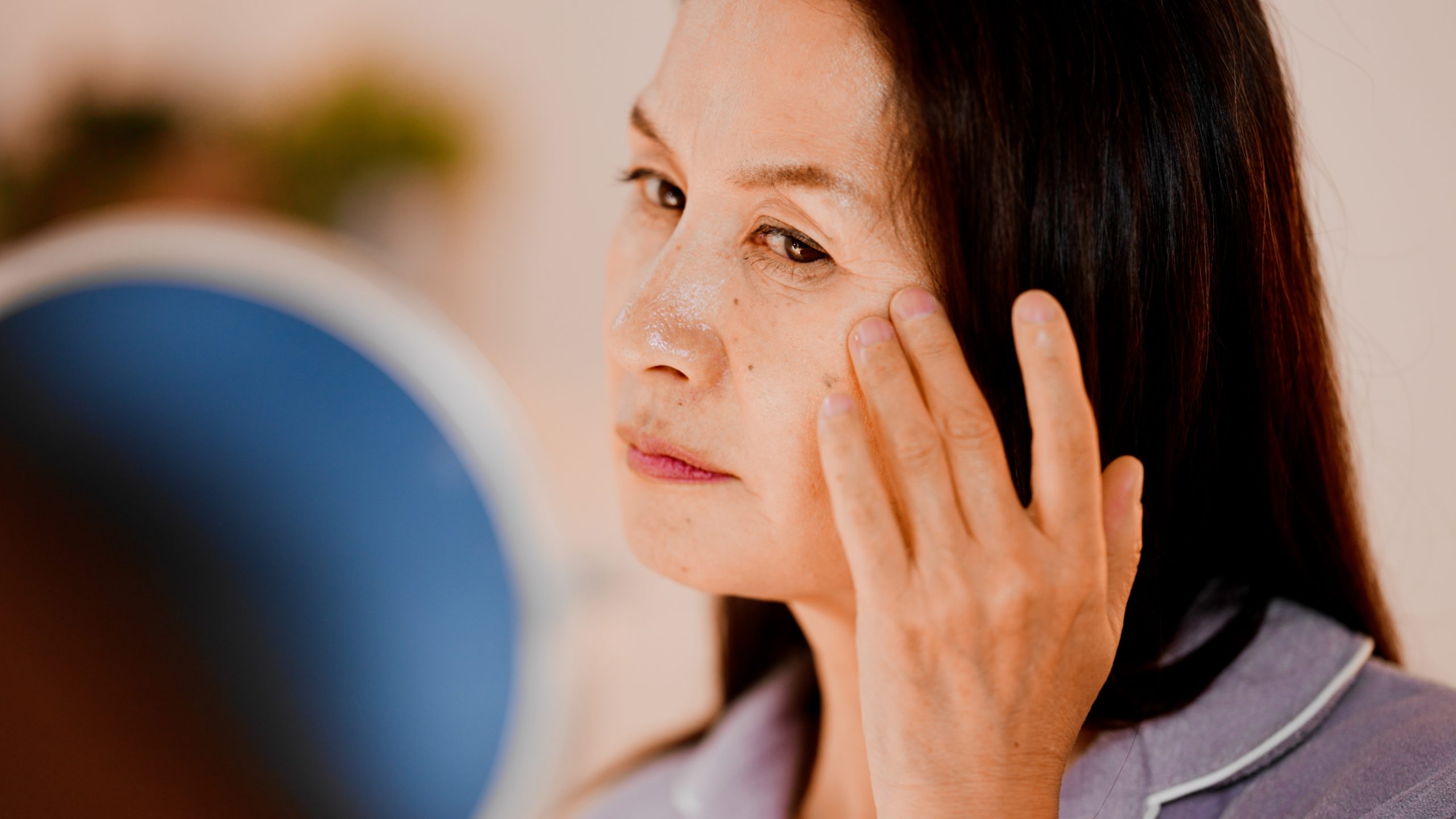
Self-care & Natural Remedies for Skin
There are many approaches to taking care of your skin that do not require prescriptions, although you should inform your healthcare provider or dermatologist of anything that you are doing – there may be impacts on treatments that they suggest or prescribe.
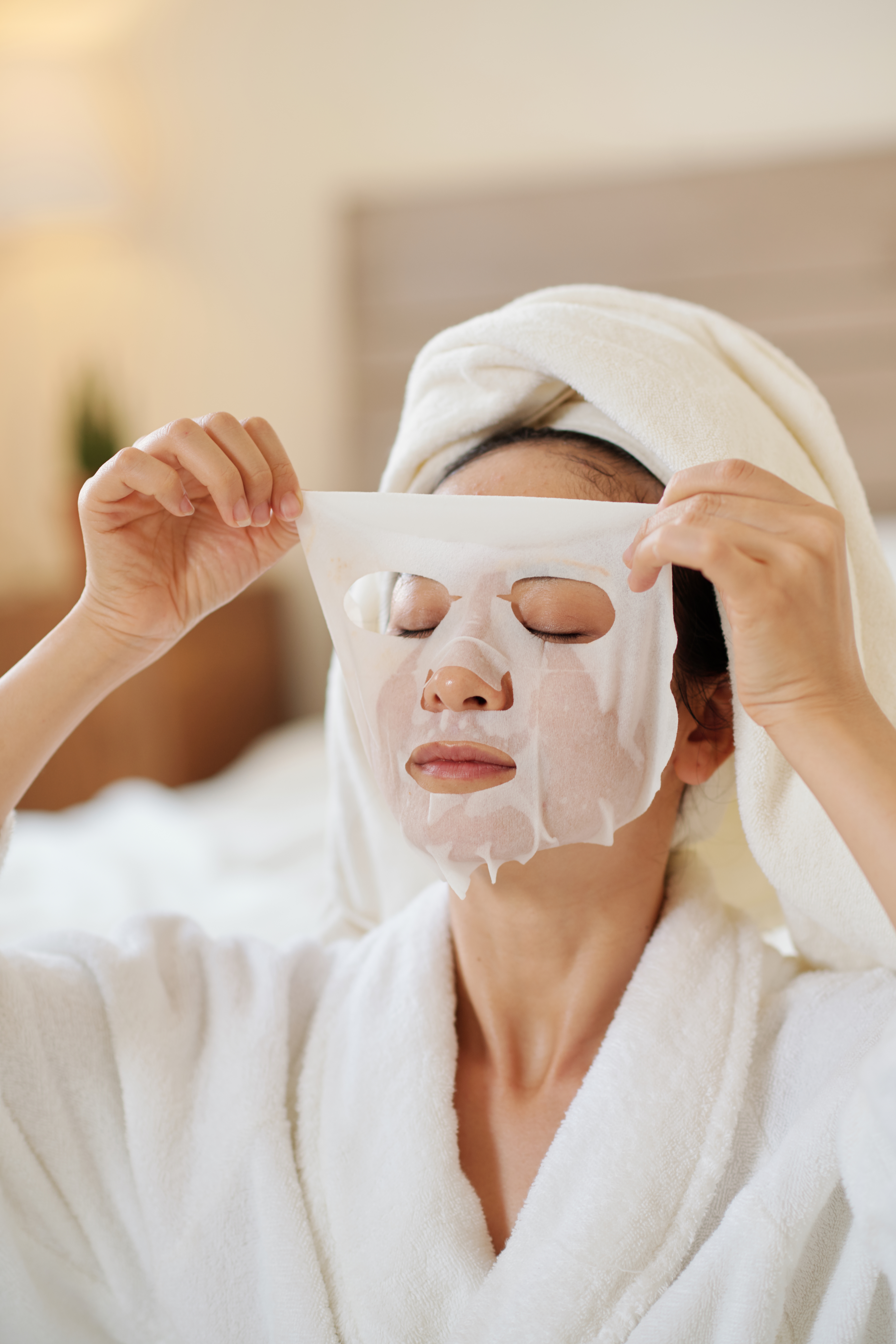
Therapy & Treatment for Skin
At age 40 find a reliable, educated primary care provider familiar with recognizing and treating symptoms of perimenopause and menopause. The North American Menopause Society provides a list of menopause practitioners here.
Many of the treatments for your skin will be over the counter, home therapies. Regular gentle cleansing with ample moisturizer, for example, is going to be the bedrock of your skin care for most signs of aging and estrogen depletion. There are treatments, however, that need to be overseen by a professional – either your regular healthcare provider or a board certified dermatologist. Hormone Therapy (HT) may be one approach, as the root of menopausal transition problems with skin are driven by changes to your hormones.
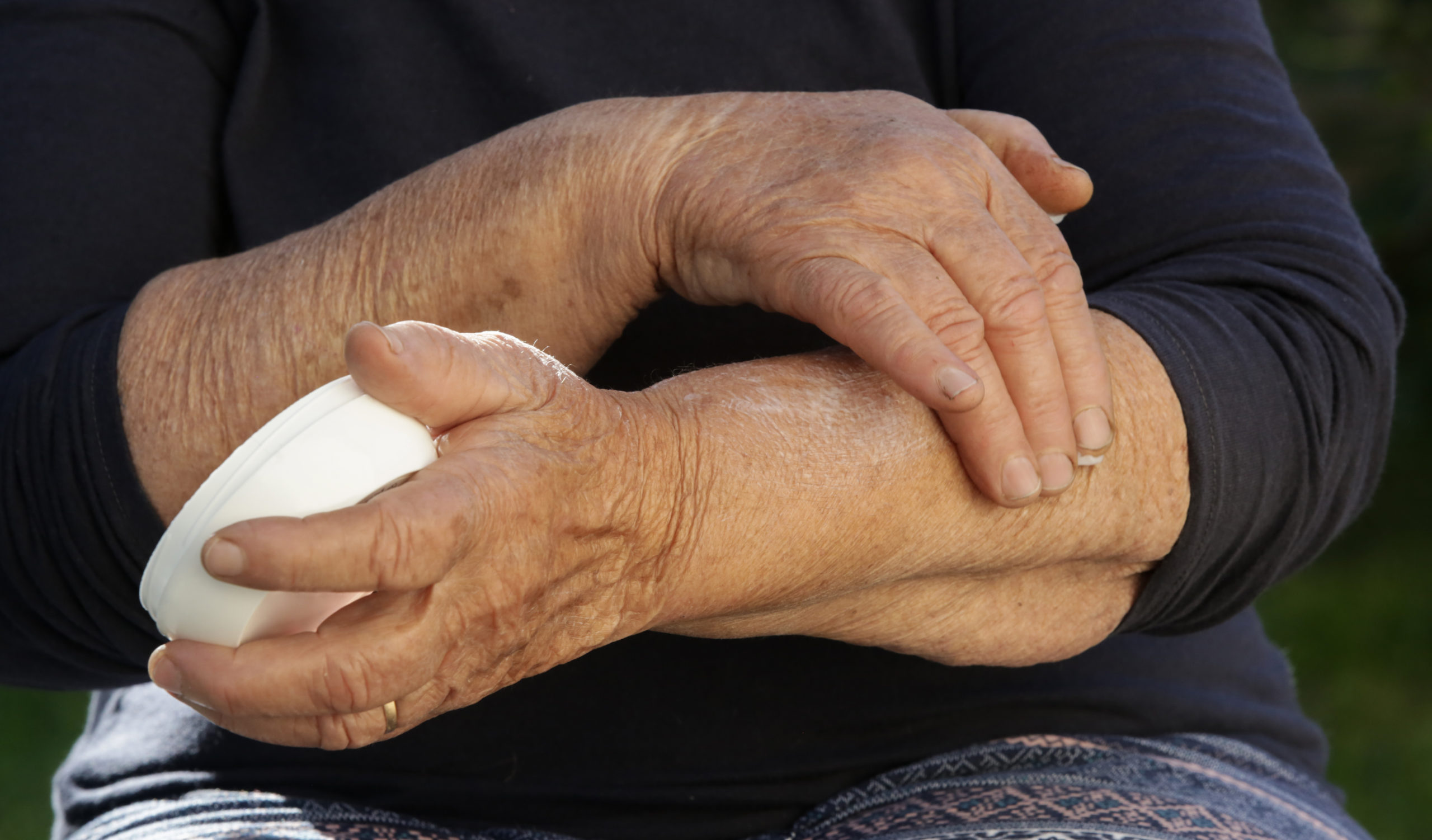
The Science
The Integumentary System: Skin
Your skin, hair, and nails together make up your integumentary system, which in addition to containing the largest organ in your body (your skin), also forms the physical barrier that protects your internal environment from the outside world. Its other functions include helping regulate your temperature and fluid balance, making Vitamin D (from sunlight) and sensing stimuli (sense of touch). The skin contains immune cells (including myeloid and lymphoid cells) some of which have the ability to activate the body’s larger immune system if necessary. The skin plays a key role in healing wounds, controlling the coagulation of cells to form a clot (a scab), inflammation, growth of new cells and the final remodeling stage resulting in new healed skin. [7]
The main parts of the integumentary system are the epidermis, dermis, hypodermis, associated glands, hair, and nails.
Myths & Mysteries
No. Absolutely not.
Your skin is not your muscles – you don’t want to feel the burn. If your skin burns, stings or tingles when you use a product it means your skin is being irritated. Stinging and burning are also indicators that the pH of your skin is being altered and your natural oils are being stripped off of the surface of the epidermis. These can all lead to more acne, blemishes, dryness or wrinkles. Be kind to your skin and use products that make it feel good.
NOT TRUE
Genetics plays a role in how you age and when your age starts to show, but like most other factors in life, there is also a large role played by your behaviour and your environment. Your natural aging process will be affected by your skin care routine and by the amount of exposure you have to sun and UV light. Other environmental factors, such as cigarette smoke, pollution, heavy drinking or chronic insomnia, can also speed up the appearance of aging.
FALSE
Wrinkles are usually the first thing that people notice as they age, but there are other signs that trained dermatologists or skin care technicians can see, including skin tone, fine lines, colour changes and changes in texture. It is never too early to start a good skin care routine that will delay the signs of aging for as long as possible.
FALSE
Research suggests that prolonged sun exposure does not increase levels of vitamin D because the body can only absorb a limited amount of vitamin D at a time. Prolonged sun exposure will, however, increase the risk of skin cancer and premature aging. Most people need about 10-20 minutes of sunlight a day to meet their vitamin D requirements. This varies slightly based on the lightness or darkness of your skin tone. You should get more than enough sun exposure walking to your corner store. If you think you could be at risk of a vitamin D deficiency speak to your healthcare provider.
NOPE
It sounds like SPF 50 is way stronger than SPF 30 but the truth is that SPF 30 sunscreens filter about 96.7% of UV radiation while SPF 50 sunscreens filter 98% of UV radiation. [17] Your sunscreen should be a minimum of SPF 30, and remember to reapply it every two hours, after swimming, sweating, or towel drying.
YES
Darker skin tones are still susceptible to cancer because UVA and UVB rays still penetrate the epidermis to the dermis. Regardless of skin type, exposure to UV radiation from the sun and other artificial sources can cause skin to be permanently damaged.
Maybe
Yes, unless the cosmetic product is labeled SPF30 or higher, is also a broad-spectrum sunblock, and you are only out for a short period of time in the sun. You will need to wear additional sunscreen under your makeup if you’re going to be in the sun for an extended period. For longer periods of time in the sun, use a separate sunscreen and reapply it every two hours. Look for the label – most cosmetics offer no sun protection whatsoever.
Not at all.
Having darker skin from a fake tan does not block UVA or UVB rays. To do this you need to use a proper broad-spectrum sunscreen. Some fake tanning products are rated with an SPF (sun protection factor), so if the SPF is above a 30 and if the product is certified broad-spectrum, you may be fine for limited exposure right after you apply it. Remember that all sunscreens need to be reapplied every few hours and after getting wet so don’t rely on your fake tan with sunscreen for long-term protection beyond what you would get with a regular sunscreen.
Not true at all.
You can get sun damage on windy, cloudy and cool days because sun damage is caused by ultraviolet (UV) light radiation, not temperature. UV radiation penetrates cloud cover and remember it is a light wave – it doesn’t get blown around. Sun damage is also possible on cloudy days, as UV radiation can penetrate some clouds, and may even be more intense due to reflection off the clouds. Most weather apps have a UV forecast that can indicate the true level of UVA and UVB rays on any given day so you can check and this will remind you to put on a broad-spectrum sunscreen.
Citations
[1] https://www.aad.org/public/everyday-care/skin-care-secrets/anti-aging/skin-care-during-menopause
[2] https://www.webmd.com/melanoma-skin-cancer/skin-sun-damage-treatment
[3] https://www.skincancer.org/risk-factors/uv-radiation/
[4] https://www.mayoclinic.org/healthy-lifestyle/healthy-aging/in-depth/easy-bruising/art-20045762
[4a] Herman, J., Rost-Roszkowska, M., & Skotnicka-Graca, U. (2013). Skin care during the menopause period: noninvasive procedures of beauty studies. Postepy dermatologii i alergologii, 30(6), 388–395. https://doi.org/10.5114/pdia.2013.39430
[4b] https://www.healthline.com/health/menopause/menopause-itching#causes
[4c] Man, M. Q., Xin, S. J., Song, S. P., Cho, S. Y., Zhang, X. J., Tu, C. X., Feingold, K. R., & Elias, P. M. (2009). Variation of skin surface pH, sebum content and stratum corneum hydration with age and gender in a large Chinese population. Skin pharmacology and physiology, 22(4), 190–199. https://doi.org/10.1159/000231524
[4d] https://www.healthline.com/health/peptides-for-skin
[5] https://www.webmd.com/diet/collagen-health-benefits
[6] Stevenson, S., & Thornton, J. (2007). Effect of estrogens on skin aging and the potential role of SERMs. Clinical interventions in aging, 2(3), 283–297. https://doi.org/10.2147/cia.s798
[7] Kim JY, Dao H. Physiology, Integument. [Updated 2022 May 8]. In: StatPearls [Internet]. Treasure Island (FL): StatPearls Publishing; 2022 Jan-. Available from: https://www.ncbi.nlm.nih.gov/books/NBK554386/
[8] https://my.clevelandclinic.org/health/symptoms/17865-body-odor
[9] https://my.clevelandclinic.org/health/diseases/16921-hair-loss-in-women
[10] https://www.healthline.com/health/beauty-skin-care/hormonal-acne#diet
[11] https://www.healthline.com/health/how-to-strengthen-nails#1.-Take-a-biotin-supplement
[12] https://www.mayoclinic.org/diseases-conditions/age-spots/diagnosis-treatment/drc-20355864
[13] https://www.healthline.com/health/microneedling
[14] https://www.mayoclinic.org/diseases-conditions/wrinkles/diagnosis-treatment/drc-20354931
[15] https://www.hopkinsmedicine.org/health/treatment-tests-and-therapies/plateletrich-plasma-prp-treatment
[16] https://www.healthline.com/health/stages-of-hair-growth
[17] https://www.cancer.org.au/iheard/does-spf50-sunscreen-give-more-protection-than-spf30





